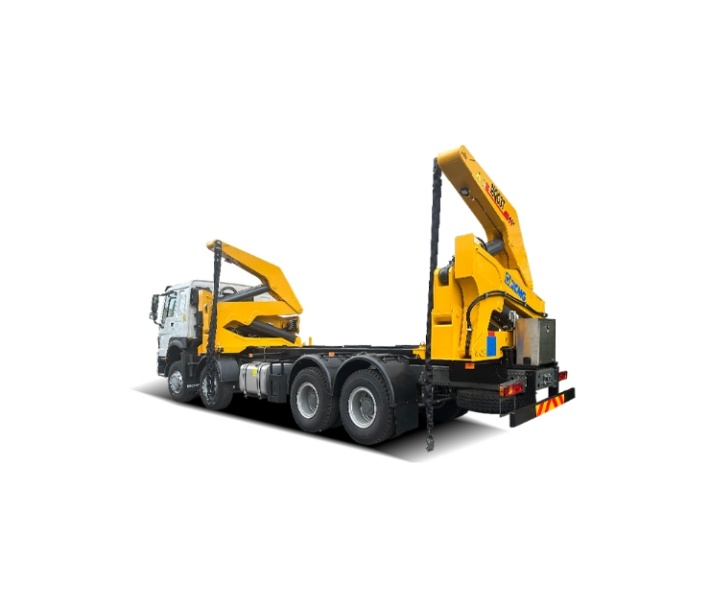The container sidelifter is a special lifting machine designed for container loading and unloading. Its structure adopts a gantry design, and the horizontal movement and vertical lifting of the container are completed through the side-extending boom. The equipment is mainly used in ports, railway freight stations and other scenes, and can adapt to the transportation needs of containers of different specifications.
Side cranes are widely used. As the service life of the crane increases and the load increases during use, the crane will also have some common faults.
According to the common faults and maintenance experience of crane equipment (including front crane, tower crane, hydraulic support, etc.), combined with the structural characteristics of side crane (hydraulic system, spreader, boom, brake system, etc.), the common fault types, cause analysis and maintenance methods of side crane are sorted out:
1. Hydraulic system failure/Défaillance du système hydraulique
1) Slow or weak lifting speed/Vitesse de levage lente ou faible
reason:
The main pump pressure is insufficient (relief valve pressure relief, pump wear);
The pilot pressure is too low (pilot valve failure or oil circuit blockage);
The hydraulic oil viscosity does not match or the oil temperature is too high (wrong oil type or cooling failure).
repair:
Check and adjust the relief valve pressure;
Replace the pilot valve filter or clean the oil circuit;
Replace the hydraulic oil with the specified oil according to the ambient temperature.
2) The arm automatically retracts or shakes/La flèche se rétracte ou tremble automatiquement
reason:
The self-locking failure is caused by the balancing valve or logic valve being stuck;
Internal leakage of oil cylinder (seal ring is damaged);
The arm slide is not lubricated enough or the clearance is too large.
repair:
Disassemble, clean or replace the balancing valve;
Replace the cylinder seal;
Add grease and adjust the slide clearance.
3) Hydraulic oil temperature rises abnormally/La température de l’huile hydraulique augmente anormalement
reason:
Cooler blockage or fan failure;
The overflow valve is under long-term pressure relief (such as the flushing valve is stuck);
There is air in the oil line (poor pipeline sealing).
repair:
Clean the cooler or replace the fan motor;
Check the flushing valve and temperature control switch functions;
Drain the oil line and tighten the pipe joints.
2. Electrical control system failure/Défaillance du système de contrôle électrique
1) Failure to start or abnormal shutdown/Défaut de démarrage ou arrêt anormal
reason:
CAN bus communication is interrupted (corroded wiring harness or loose plug);
The power supply of the control unit (such as KCU, EDC) is abnormal;
The sensor (proximity switch) has failed.
repair:
Check the damaged points of the wiring harness and replace them, clean the plug;
Measure the control unit voltage and replace the faulty module;
Calibrate or replace proximity switch.
2) Display screen alarm/Alarme sur l’écran d’affichage
reason:
Communication error (such as transmission/engine control unit signal loss);
Sensor out of range (pressure, temperature, etc.).
repair:
Check the maintenance manual to analyze the code and check the corresponding circuit;
Reset the system or replace the faulty sensor.
3. Failure of the lifting system/Défaillance du système de levage
1) The lock does not work/La serrure ne fonctionne pas
reason:
The proximity switch signal is abnormal;
The hydraulic valve block is stuck (such as the telescopic valve block is stuck);
The oil cylinder is leaking or the mechanical tie rod is deformed.
repair:
Check the proximity switch position and wiring;
Clean the valve core or replace the solenoid valve;
Test the pressure-maintaining performance of the cylinder and calibrate the tie rod.
2) The extension and retraction of the spreader are not synchronized or stuck
L’extension et la rétraction de l’épandeur ne sont pas synchronisées ou bloquées
reason:
The oil pressure on both sides is uneven (improper adjustment of the overflow valve);
The mechanical guide rail is deformed or blocked by foreign objects.
repair:
Adjust the relief valve pressure of the solenoid valve block to balance;
Clean and grease the guide rails.
4. Braking system failure/Défaillance du système de freinage
1) The vehicle brakes are weak or locked/Les freins du véhicule sont faibles ou bloqués
reason:
Insufficient accumulator pressure (nitrogen leakage);
The brake valve is stuck or the oil circuit is inflated;
Excessive brake pad wear.
repair:
Refill nitrogen or replace accumulator;
Clean the brake valve and exhaust the air in the oil circuit;
Replace brake pads.
2) Parking brake failure/Défaillance du frein de stationnement
reason:
The parking solenoid valve is burned out;
Relay signal interrupted (sensing slide stuck).
repair:
Replace the solenoid valve;
Clean the sensor slide and check the wiring.
5. Mechanical structure failure/Défaillance de la structure mécanique
1) The wire rope is worn or broken/Le câble métallique est usé ou cassé
Cause: Overload, eccentric wear of the pulley or insufficient lubrication.
repair:
Replace the wire rope immediately;
Correct the pulley groove and apply grease regularly.
2) Abnormal noise or oil leakage from reducer/Bruit anormal ou fuite d’huile du réducteur
reason:
Gear pitting (poor lubrication or assembly error);
The sealing ring is aging or the box is cracked.
repair:
Replace the gears and add high-quality lubricating oil;
Replace seals or repair housing.
6. Preventive maintenance recommendations/ Recommandations de maintenance préventive
Regular inspection:/Inspection régulière :
Hydraulic oil quality/oil level (every 250 hours);
Wire rope wear (daily visual inspection);
Electrical wiring harness protection (anti-corrosion, anti-abrasion).
Selection by working conditions:/Sélection par conditions de travail :
Hydraulic oil type (VG32 for low temperature environment, VG68 for high temperature/high load);
Brake oil needs to be resistant to high temperatures.
Training operation specifications:/Spécifications de l’opération de formation :
Avoid sudden start and stop to reduce hydraulic shock;
Overloading is strictly prohibited.
Post time: May-28-2025

